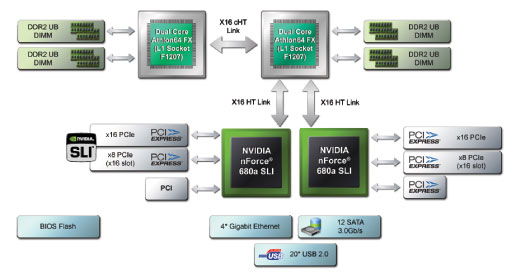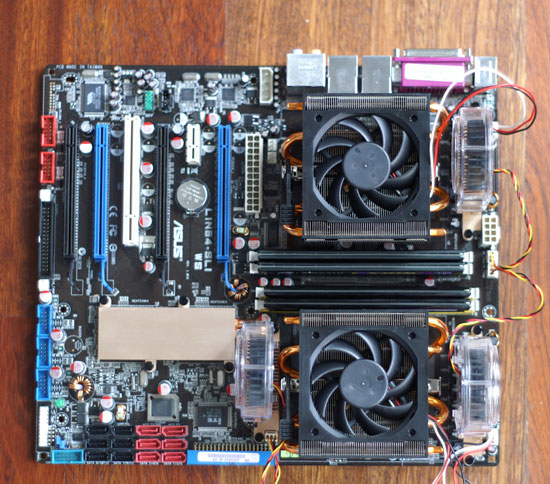AMD's Quad FX: Technically Quad Core
by Anand Lal Shimpi on November 30, 2006 1:16 PM EST- Posted in
- CPUs
The Platform
With the recent ATI acquisition under its belt, AMD has started down the path of becoming a platform company. As such it's almost fitting that the most interesting part of today's story isn't the CPUs, but rather the chipset and motherboard that complete Quad FX.
When AMD first talked about Quad FX as 4x4, everyone assumed that we would be looking at a pair of Socket-AM2 CPUs on a desktop motherboard. However as we got closer to launch it quickly became evident that Quad FX would be using Opteron's new Socket-1207 instead. The reason for using Socket-1207 instead of AM2 is simple; in a single socket AM2 system you only need a single Hyper Transport link between the CPU and the chipset, which is provided for in AM2 CPUs. However, with two sockets you need a minimum of two links, one connecting the two sockets and one for the chipset. It's the number of HT links required that forced the 1207-pin socket upon Quad FX. We will get to how this impacts your upgrade path and CPU costs later, but for now just know that Quad FX only works with 1207-pin Athlon 64 FX CPUs (Opterons are prevented from working in the BIOS).
Despite the ATI acquisition, the only Quad FX chipset available at launch is from NVIDIA. Dubbed the nForce 680a, NVIDIA once again gives us a reason to respect its platform group. Although singular in name, the nForce 680a is composed of two 680a SLI chips, each with a x16 and x8 PCIe slot. One of the two chips has an additional 8 PCIe lanes bringing the total up to 56 lanes, more than any other NVIDIA chipset, including the recently released 680i.

The madness doesn't end with the sheer number of PCIe lanes; the 680a also supports a total of four GigE ports, twelve SATA ports and twenty USB 2.0 ports. All of the usual nForce features are present on the 680a, including SLI support, RAID and NVIDIA's networking (FirstPacket and Teaming support). The chipset is a pure beast and we were eager to see an implementation of all of the PCIe, GigE, SATA and USB ports that the 680a supports on the first Quad FX motherboards; unfortunately we were met with disappointment.

AMD's Quad FX platform is launching with a single motherboard partner, ASUS, and a single Quad FX motherboard: the L1N64-SLI WS. The ASUS board features four physical x16 slots (two x16 and two x8), a single x1 PCIe slot and one regular PCI slot.

You also get all twelve SATA ports, but there's only support for ten USB ports and two GigE ports. Obviously the number of people that will complain about not having all twenty USB ports and four GigE ports are limited, but with AMD expecting the L1N64-SLI WS to retail for around $370, we wanted all of the bells and whistles.

We asked AMD when we could expect other Quad FX motherboard designs but at this point it looks like the ASUS solution is it. AMD is working with more motherboard partners but there's no indication if or when additional Quad FX designs will surface.

AMD is guaranteeing a bit of an upgrade path to early adopters of Quad FX by promising that these motherboards will work with AMD's native quad-core CPUs when they are available next year, meaning you'll get support for eight cores in the same platform in less than a year.










88 Comments
View All Comments
Neosis - Friday, December 1, 2006 - link
However (in my opinion) since all these four cores share the same 8MB L2 cache and Intel's memory disambiguation forces all cores to use L2 cache more, additional latencies are not significant as the Amd's 4x4 platform. But you are right again that connecting the dies through the FSB requires all die to die communication to go back to the Northbridge and into the system memory. That can be a serios perfomance issue when Amd has competing processers.
mino - Friday, December 1, 2006 - link
Kentsfield == 2 Conroes stuck on 1 FSB. They have _separate_ 4M L2 cache. No 8M L2 on the horizon..Neosis - Thursday, November 30, 2006 - link
Where is edit button?The first sentence should be "I think ..."
Neosis - Thursday, November 30, 2006 - link
I don't think AMD can compete with Kenstfield even with this platform. Enthuiasts usually don't care power consumption and heat problems. A water cooling system (with a large radiator and a strong pump) will do just good. The main concern is neither the power consumption nor the heat problems. When you install two dual core processor, you are going to have performance down due to the increased latency. Nearly in all benchmarks Intel is leading. No suprise that only one motherboard manufacturer was in on.Even though I'm an AMD user, I don't see any particular reason people will buy this. But I can say why not:
- no one knows how long Amd will support this platform. In the past years Amd has beem changing sockets almost each year and half. We know Socket Am3 will use Ddr3.
- pricing
Griswold - Saturday, December 2, 2006 - link
Well the first part isnt quite true or very precise, as for the second part, we also know that AM3 CPUs will run in AM2 sockets (but not vice versa). On top of that, we're talking about Socket F here and not AMx.
If you want to name a good reason to not buy this: The other option is just that much better. End of story. If you want quad AMD, wait 6 months.
Gigahertz19 - Thursday, November 30, 2006 - link
On black Friday I was at Circuit City and some store employee near me was telling this woman who was looking for a computer to make sure she buys a computer with a AMD processor because their faster and all around better. I couldn't stand there and let him lie to that woman so I went over there and told her she needs to buy a comp with a Core 2 Duo and gave my reasons. Then the Circuit City guy went into this rant about AMD and the 5000+ processor and how it's the best, haha apparently he hasn't updated his knowledge for quite sometime. I could of stood there and argued it but I just said okay and walked away, didn't walk to make a scene...plus how geeky would that be arguing over processors in the middle of a store where customers are.Anyways looks like Intel Core 2 Duo tech is the thing to get. I'm stilling running a old XP-M overclocked with a DFI Socket A mobo. I want to upgrade to Core 2 Duo sometime soon probably get the Core 2 E6600 only because it has 4Mb cache and the slower speed ones don't. Overclock that baby to 3GHz which should be a given with the right mobo like the Evga one and I'll have a awesome system, probably buy a X1950 XT or Pro for around $250 then upgrade to DX10 when it gets cheaper.
madnod - Thursday, November 30, 2006 - link
i am really into AMD and i was buying AMD since the last 4 years, but this time intel isreally pushing ahead.there is a major thing that intel is doing these days and it's really funny to see the way AMD is responding to that, it kinda remind me of the 3DFX approach, start stacking more things that u already have and wish that things will be better.
AMD should expedite their transition to the newer CPU desgin, the current K8 architecture can't keep up with the core technology.
THX - Thursday, November 30, 2006 - link
Very nice tests. I can't believe the power draw AMD is dealing with here.Ecmaster76 - Thursday, November 30, 2006 - link
The pin count of AM2 probably isn't an issue. It has as many pins as 940 which can handle multiple HT links and dual channel memory.AMD just moved it tot he other socket to people from buying the bundled CPUs and selling them individually for a profit. The 2.6 GHz model for example runs about $100 less per chip than the standard X2 does.
punjabiplaya - Thursday, November 30, 2006 - link
Are we going to see updated benchmarks with 64 bit performance and/or Vista and when there is a BIOS fix for the NUMA issues on the board (not the WinXP shortfalls as far as NUMA is concerned, Vista should take care of that)?Just curious.